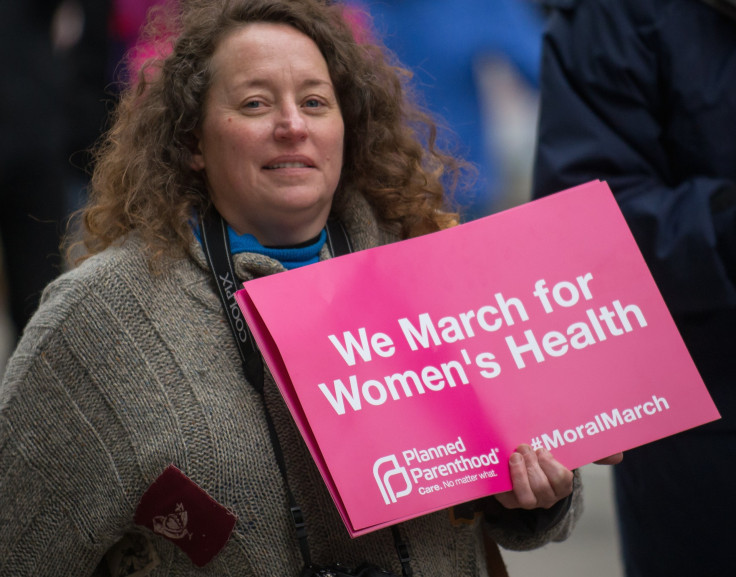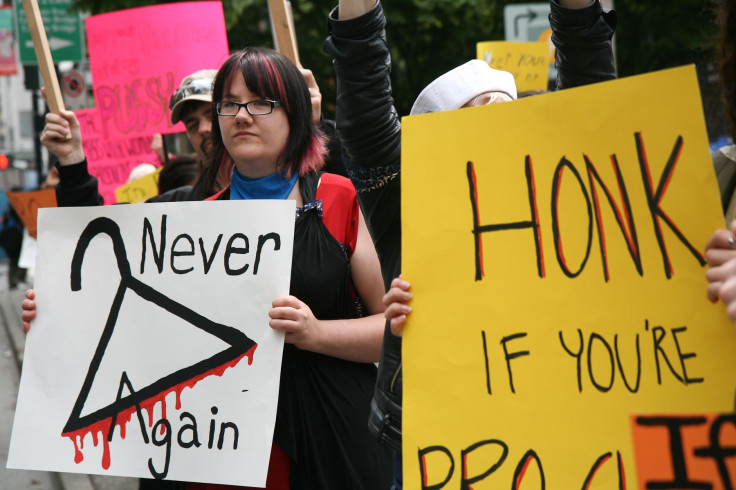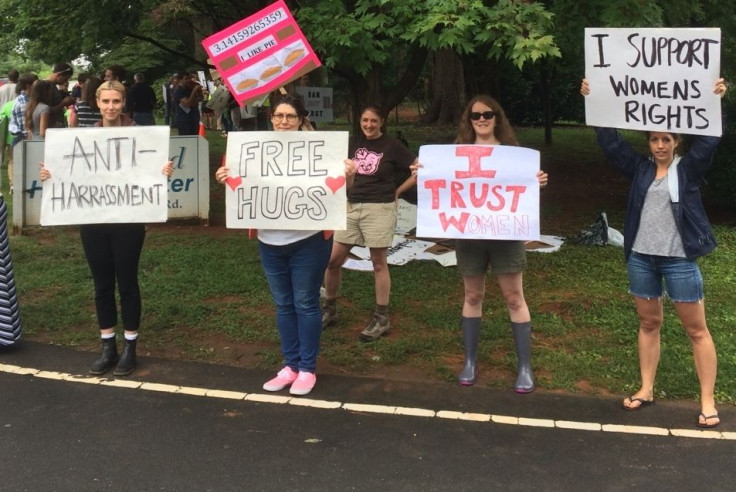The Abortion Debate Needs To Change: Instead Of Pro-Life vs. Pro-Choice, Let's Be Pro-Women

I don’t regularly write about women’s issues. If I do, I’m on the health end of the spectrum, comparing the differences women and men face when it comes to diseases and addiction. But in the few times I’ve covered news regarding abortion — news there’s been no short supply of lately — I’ve come to rely on a single Twitter follower to backhandedly compliment me. “Great story!” he’ll tweet. “Abortion history links, here and here.” The history, of course, concludes that it's misguided to be pro-choice.
A quick reminder: Pro-choice and pro-life are the two camps aggressively held in the great abortion divide; there isn't really a middle ground. Each camp is self-explanatory, but for anyone confused, pro-choice refers to the group of people who believe women have the fundamental right to do what they want with their bodies. Pro-life refers to the group of people who simply oppose this idea (to say the least), believing that women who carry their pregnancy to term don’t just save their babies, but their own lives, too.
There’s a convincing pro-choice portion of history my Twitter troll conveniently glazes over. Before landmark case Roe V. Wade was passed in 1973, ruling that “states were forbidden from outlawing or regulating any aspect of abortion performed during the first trimester of pregnancy,” abortions were legal only in New York and California. David A. Grimes, author of Every Third Women in America: How Legal Abortion Transformed Our Nation, wrote that “tens of thousands of women living in the United States made interstate trips to get safe abortion care in the early 1970s.” These treks “led to preventable complications and death.”
In fact, in 1965, Planned Parenthood reported 17 percent of all deaths due to pregnancy and childbirth were a result of an illegal abortion. Today, adverse effects from an abortion occur less than a quarter of the time. Despite evidence legal abortion reduces maternal deaths, relieves financial strain, and empowers both men and women to pursue related educational and employment opportunities unheard of in the time leading up to the court’s decision, legislation and anti-abortion groups have misguidedly renewed their attack on women’s rights with fervor — and it’s nothing short of frightening.
A recent survey from anti-abortion group Operation Rescue found there are nearly 25 percent less abortion clinics open today than there were five years ago; 60 surgical clinics closed in 2014 alone. Texas may soon close a majority of the state’s clinics pending an upcoming hearing, while Arizona passed a law stating childbirth and adoption are to be taught as the preferred options to elective abortion. This law empowered a Christian legal advocacy group to influence an Arizona school district to remove two pages of a biology textbook that went over abortion. It was the "simple, least invasive" option, the district said.
It’s hard to believe that people who sling phrases like “abortion cartel” can significantly influence a woman’s reproductive rights. Then again, when you consider the backwards legislation some states perpetuate, I guess it isn’t. All this does is empower anti-abortion groups and organizations to promote false ideas. Arizona aside, one analysis from the Guttmacher Institute (GI) found that leading pro-life organizations were saying some methods of contraception constitute abortion. Yet, they stayed silent when their claim was condemned as radical.
“The influential organizations driving this anti-contraception agenda have compartmentalized the debate,” Joerg Dreweke, author of the analysis, said in a press release. “They portray some contraceptives as abortion when doing so is politically expedient, while striving to avoid the perception that they are engaged in a full frontal assault on birth control. For instance, they do not apply their full anti-abortion agenda to these contraceptive methods, knowing it would be politically toxic if they extended waiting periods, mandatory ultrasounds, and onerous clinic regulations to IUDs and Plan B.”
To Grimes, “incorrect, misleading, and inflammatory language” hurts rather than helps the conversation on abortion.

The Truth About Abortion
Here are the facts: Half of pregnancies among American women are unintended, according to GI, and four in 10 of these are terminated by abortion. Forty-two percent of these women have an income below the federal poverty level, giving credence to the three-fourths of women who say they cannot afford a child. Parental responsibility, interference with work, school, or otherwise care for dependents, as well as the reality of raising a child as a single parent are common reasons why women choose to get an abortion. There is also the one percent of women who abort pregnancies as a result of rape and incest; a study from the Melisa Institute found "a history of sexual abuse and violence is a risk factor for abortion and subsequent mental health problems."
Contrary to popular belief, the majority of women making these decisions aren’t sexually active teens. While 18 percent of women who opt for abortion are younger adults, it’s women in their 20s who account for more than half of all abortions. Women with one or more children, meanwhile, account for 61 percent of abortions. And to put it another way: One in three women will have an abortion by the time they’re 45 for multiple and diverse reasons.
In the U.S. when these women choose to have an abortion, they are given the choice between two kinds — a surgical abortion and a medication abortion. Each requires several consultations with a doctor, and they are very effective. It’s worth noting that the pill, which is taken in conjunction with other antibiotics, works 97 out of every 100 times. There’s a second (also safe) procedure available to women in the event the pill does not work. It’s recommended that regardless of which abortion a woman is getting, they do so during the first eight to 12 weeks. Any later than that and a woman risks her safety and chances of getting pregnant in the future. A third-trimester abortion is only carried out for life-threatening reasons.
But as states implement new laws attacking abortion clinics, we are left wondering: what happens when women are denied an abortion? The New York Times posed this question in 2013, citing research from Diana Greene Foster, a demographer and associate professor of obstetrics and gynecology at the University of California, San Francisco. Her study focused on 30 abortion clinics from 21 states across the country. Of the 956 women who completed an initial and follow-up interview, 452 received an abortion within weeks of their clinic’s cut-off and 231 were turned away. Twenty percent of those rejected women received an abortion elsewhere — sometimes 150 miles away from home.
Greene found that “turnaways'” physical health and economic stability suffered, with effects like "higher rates of hypertension and chronic pelvic pain." (Foster could not say, however, whether turnaways faced greater risk of pregnancy than an average woman.) She also found that later abortions were safer than childbirth for some women, as they experienced lower rates of complications and incidences of chronic conditions. Still, Greene added that most women who go through with childbirth rarely regret their child.
“It’s psychologically in our interest to tell a positive story and move forward,” she said. “It’s wonderfully functional for women who have children to be glad they have them and for women who did not have children to enjoy the opportunities that afforded them.”
This doesn’t negate the fact women know what’s best for their physical and mental health. Improving access to reproductive health care, Greene said, reduces the number of women who seek an abortion too late. When an abortion is harder to find, “all the logistic concerns snowball — money, travel, support.”

Power In Numbers
It's difficult to reconcile an abortion as a healthy alternative to childbirth, especially when you consider the science that suggests women who give birth are generally happy afterwards. But, it’s even more difficult to reconcile how the U.S. is backtracking to a time when women were forced underground after not being able to find safe and legal reproductive care. Somewhere along the line, it became fashionable (again) to distrust and dehumanize women who want an abortion.
The silver lining is that this brings out women who have undergone the procedure — for a variety of reasons — in droves. Advocates for Youth’s (AFY) 1 in 3 Campaign is one such example of a group trying to round out the reproductive conversation. Deb Hauser, head of AFY, told NPR that her personal beliefs about keeping abortions secret have changed.
"If we are silent, what's left is this void for other people to fill, and they've filled it with a lot of shame and judgment," Hauser said. "We have to make the political the personal now, and we have to stand up and put women's real-life stories in the middle of this dialogue around abortion care or we're gonna lose."
The group behind Saturday Chores is another example of women (and men) standing up for reproductive rights. What started out as a young couple picketing anti-abortion groups with their comical signs — "Weird hobby" and "I like turles" are two popular ones — ended up attracting other like-minded indviduals who spend their Saturday mornings promoting change, too.
Some of these pro-choice protesters are pregnant themselves. One woman in the UK slammed an anti-abortion group protesting outside of a clinic. She had seen a man videotaping women going inside, even though he said the camera was off (a woman accused him of having it on when the red recording light was clearly visible). “It’s wrong what you’re doing," the unidentified woman said. "You don’t know why people are doing what they’re doing, but you want to be out here judging and filming. … For you to stand out here and make women feel guilty is so wrong, so f*cking wrong.”
Still, all these anti-pro-life protests don't necessarily change pro-lifers perception of pro-choice groups. We must help them realize the struggles that women who seek abortions face, and the way these struggles impede a woman's ability to care for a child. To do this, we can take notes from a Think Progress research project from last month, which focused on the effects of political canvassing. Preliminary results showed that “when abortion opponents have an in-person conversation with a woman who’s chosen to end a pregnancy, they’re more likely to shift their view about whether the procedure should be legal.” These outspoken women can inspire change if they rally enough women to lend their voice to that change — something that will admittedly take time.
Until then, pro-choice and pro-life groups are going to continue to present the health advantages for their respective stance; they do, after all, exist in both. But so long as this is the case, let's resolve to be pro-women. They have the right to choose what to do with their body. A choice that's, to be frank, no one's business but their own.



























